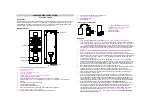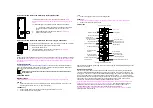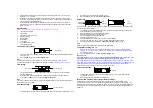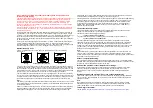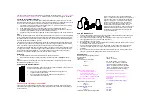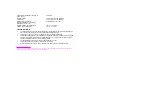
WIRELESS WEATHER STATION
Instruction manual
Introduction:
Congratulations on purchasing this state-of-the-arts Weather Station with radio-controlled time as an
example of fine design and quality piece of engineering. The operation of this product is easy and
straightforward. By reading this operating manual, users will receive a better understanding of the
Weather Station together with the optimum benefit of all its features.
Weather Station
•
Radio controlled time with manual setting option.
•
12/24 hour time display
•
Calendar display
•
Time zone selectable (±12 hours)
•
Moon phases display
•
Degree Celsius or Fahrenheit temperature selectable
•
Current indoor temperature display
•
Simultaneous minimum and maximum indoor temperatu re recordings
•
Current relative
indoor humidity
display with "
☺
" Smiling or "
L
" Sad face for comfort level
reading
•
3 weather icons for weather forecasting
•
Weather tendency indicator
•
Current outdoor temperature display
•
Simultaneous minimum and maximum outdoor temperature recordings
•
Current relative outdoor humidity display
•
Manual minimum and maximum temperature recording resets
•
LCD contrast changeable to 8 different tones
•
Can take up to 3 outdoor transmitters
•
Low battery indicator
•
Wall mounting
Thermo-hygro Transmitter:
•
Remote transmission of outdoor
temperature
and humidity to weather
station by 433 MHz signals
•
Rain proof casing
•
Wall mounting case
Setting up:
1.
First, insert the batteries into the Weather
station (see
How to install and replace the
batteries in the weather station
below).
Once the batteries are in place, all segments of the
LCD will light up briefly, then the indoor temperature and humidity, the time as “-:--“, the date as
“------“ , the Moon phase and the weather icons sun and clouds will be displayed. If the indoor
temperature and humidity are not displayed after a few seconds, remove the batteries and wait
for at least 10 seconds before reinserting them. Once the indoor data is displayed proceed to
step 2
.
2.
Within 3 minutes of activating the Weather station, place the batteries into the transmitter
(see
How to install and replace the batteries in the Thermo-hygro transmitter
below).
3.
After inserting the batteries into the transmitter, the Weather station will start receiving data from
the transmitter. The outdoor temperature and humidity should then be displayed on the Weather
station. If this does not happen after
10 minutes
, the batteries will need to be removed from
both units and reset from
step 1
.
4.
The Weather station can take up to 3 remote transmitters. If you have
purchased
additional
transmitters, follow step 2 for all extra transmitters. However, ensure that you leave 10 seconds
in between the reception of the last transmitter and the set-up of the following transmitter. The
Weather station will number the transmitters in the order of set-up, i.e. the first transmitter will
have the temperature displayed with the number 1 against it and so on.
5.
When all the transmitters are set up, there is a testing period, during which the display switches
quickly between all the received transmitters at random, according to which random
transmission it receives. Pressing any key will stop this process and the display will show the
temperature and humidity for the first transmitter. The process also stops automatically if no
keys are pressed for a few minutes.
6.
Once the remote temperature has been received and displayed on the Weather station, the
DCF-77 time code reception is automatically started. This takes typically between 3-5 minutes
in good conditions. This time period is an excellent opportunity to locate the transmitter(s) in
suitable location(s) outdoors. In order to ensure sufficient 433 MHz transmission however, this
should under good conditions be no more
than 20 - 25 meters
from where the Weather station
will be finally positioned (see notes on
“Positioning”
and
“433 MHz Reception”
).
7.
If after 10 minutes, the DCF time has not been received, use the SET key to manually enter a
time initially. The clock will then automatically attempt a new reception the next full hour or as
long as one DCF reception is successful. When this is successful, the received time will
override the manually set time. The date is also updated with the received time. Also a radio
reception always take place between 00
:00 am and 06:00 am each day (attempts DCF
reception every full hour within this time framer.
Please refers to notes on “
Radio controlled
time
” and “
Manual time setting
”).
Hanging hole
LCD display
CHANNEL key
RESET key
SET key
+
key

